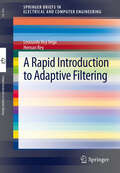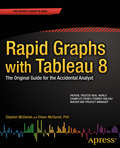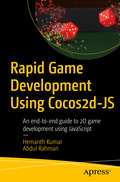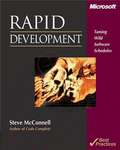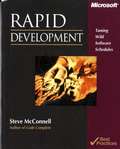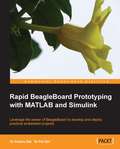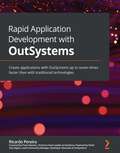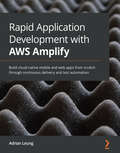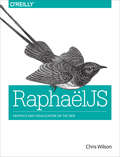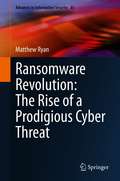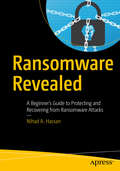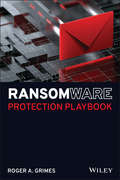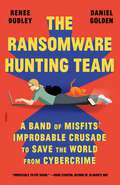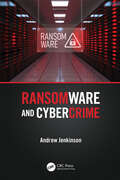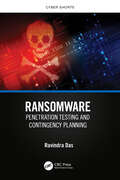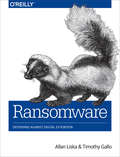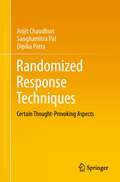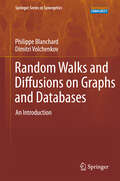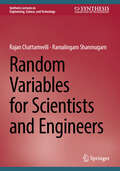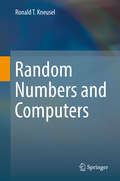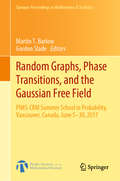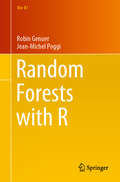- Table View
- List View
A Rapid Introduction to Adaptive Filtering (SpringerBriefs in Electrical and Computer Engineering)
by Hernan Rey Leonardo Rey VegaIn this book, the authors provide insights into the basics of adaptive filtering, which are particularly useful for students taking their first steps into this field. They start by studying the problem of minimum mean-square-error filtering, i.e., Wiener filtering. Then, they analyze iterative methods for solving the optimization problem, e.g., the Method of Steepest Descent. By proposing stochastic approximations, several basic adaptive algorithms are derived, including Least Mean Squares (LMS), Normalized Least Mean Squares (NLMS) and Sign-error algorithms. The authors provide a general framework to study the stability and steady-state performance of these algorithms. The affine Projection Algorithm (APA) which provides faster convergence at the expense of computational complexity (although fast implementations can be used) is also presented. In addition, the Least Squares (LS) method and its recursive version (RLS), including fast implementations are discussed. The book closes with the discussion of several topics of interest in the adaptive filtering field.
Rapid Graphs with Tableau 8: The Original Guide for the Accidental Analyst
by Stephen McDaniel Eileen McDanielTired of boring spreadsheets and data overload from confusing graphs? Master the art of visualization with Rapid Graphs with Tableau 8! Tableau insiders Stephen and Eileen McDaniel expertly provide a hands-on case study approach and more than 225 illustrations that will teach you how to quickly explore and understand your data to make informed decisions in a wide variety of real-world situations. Rapid Graphs with Tableau 8 includes best practices of visual analytics for ideas on how to communicate your findings with audience-friendly graphs, tables and maps."A picture is worth a thousand words" is a common saying that is more relevant today than ever as data volumes grow and the need for easy access to answers becomes more critical. This book covers the core of Tableau capabilities in easy-to-follow examples, updated and expanded for Version 8. Learn how to be successful with Tableau from the team that started the original training program as the founding Tableau Education Partner! "A must read for anyone interested in Tableau. Clear explanations, practical advice and beautiful examples!"Elissa Fink – Chief Marketing Officer, Tableau Software
Rapid Game Development Using Cocos2d-JS
by Hemanth Kumar Abdul RahmanGet a gentle introduction to the Cocos2d-JS framework to begin working with sprite manipulations, animations, and other 2d game development topics. This book covers environment setup and getting started with a framework that works seamlessly across all browsers. Rapid Game Development Using Cocos2d-JS teaches you the overall architecture of Cocos2d-JS and explains the internal working of the framework. You will dive deep into sprites, the most important entity in Cocos2d-JS, animation APIs, and primitive shapes. You'll also learn about the Cocos2d-JS UI system to get a head start in 2d game development. Finally, you'll discover the features of Chipmunk (the built-in physics engine) with full examples. What You'll Learn Get a simple head start in Cocos2d-JS Gain an architectural overview of the different blocks of the framework Master sprites, spritesheets, and frame animation Work with the event system in Cocos2d-JS Discover the animation APIs in Cocos2d-JS Leverage the built-in physics engine Who This Book Is For Beginners looking to develop cross-platform mobile/web games with cocos2d-js, developers with intermediate skills on cocos2d-js looking for the reference.
Rapid Development
by Steve McconnellCorporate and commercial software-development teams all want solutions for one important problem--how to get their high-pressure development schedules under control. In RAPID DEVELOPMENT, author Steve McConnell addresses that concern head-on with overall strategies, specific best practices, and valuable tips that help shrink and control development schedules and keep projects moving. Inside, you'll find: A rapid-development strategy that can be applied to any project and the best practices to make that strategy work Candid discussions of great and not-so-great rapid-development practices--estimation, prototyping, forced overtime, motivation, teamwork, rapid-development languages, risk management, and many othersA list of classic mistakes to avoid for rapid-development projects, including creeping requirements, shortchanged quality, and silver-bullet syndromeCase studies that vividly illustrate what can go wrong, what can go right, and how to tell which direction your project is goingRAPID DEVELOPMENT is the real-world guide to more efficient applications development.
Rapid Development: Taming Wild Software Schedules
by Steve M. McconnellGet your development schedules under control and on track! Corporate and commercial software-development teams all want solutions for one important problem--how to get their high-pressure development schedules under control.
Rapid BeagleBoard Prototyping with MATLAB and Simulink
by Dr Xuewu Dai Dr Fei QinThis book is a fast-paced guide with practical, hands-on recipes which will show you how to prototype Beagleboard-based audio/video applications using Matlab/Simlink and Sourcery Codebench on a Windows host.Beagleboard Embedded Projects is great for students and academic researchers who have practical ideas and who want to build a proof-of-concept system on an embedded hardware platform quickly and efficiently. It is also useful for product design engineers who want to ratify their applications and reduce the time-to-market. It is assumed that you are familiar with Matlab/Simulink and have some basic knowledge of computer hardware. Experience in Linux is favoured but not necessary, as our software development is purely on a Windows host.
Rapid Application Development with OutSystems: Create applications with OutSystems up to seven times faster than with traditional technologies
by Ricardo Pereira Paulo Moreira Taiji HaginoDiscover best practices to create simple, robust, and scalable software solutions quickly and securely, and focus on what's important - the business and the end customerKey FeaturesDiscover strategies and tips for low-code and no-code development with the help of useful examplesBuild enterprise-scale reactive web and mobile applicationsExplore the benefits of low-code developmentBook DescriptionOutSystems is a software development platform that speeds up the build phase by abstracting code and making almost everything visual. This means replacing textual language with visual artifacts that avoid lexical errors and speed up code composition using accelerators and predefined templates.The book begins by walking you through the fundamentals of the technology, along with a general overview of end-to-end web and mobile software development. You'll learn how to configure your personal area in the cloud and use the OutSystems IDE to connect with it. The book then shows you how to build a web application based on the best architectural and developmental practices in the market, and takes the same approach for the mobile paradigm. As you advance, you'll find out how to develop the same application, and the great potential of reusing code from one paradigm in another and the symbiosis between them is showcased.The only application that'll differ from the application in the exercise is the one used in business process technology (BPT), with a focus on a common market use case.By the end of this OutSystems book, you'll be able to develop enterprise-level applications on the web and mobile, integrating them with third parties and other systems on the market. You'll also understand the concepts of performance, security, and software construction and be able to apply them effectively.What you will learnGet to grips with the OutSystems infrastructureDevelop reactive web and mobile applications in OutSystems using best practices in Service StudioDefine and design Architecture Canvas (3-Layer Canvas) for your applicationsIntegrate with external systems in OutSystemsEnhance applications with BPTManage and monitor your applications in the OutSystems infrastructureWho this book is forThis book is for back-end developers, tech leaders, UX/UI developers, frontend developers, (in general, full-stack developers), tech companies, and enterprises looking to learn how to develop web and mobile software quickly and disruptively by leveraging OutSystems, one of the most low-code platforms in the market. An IT background is not mandatory; however, experience in SQL, JavaScript, HTML, CSS, and C# is required to get started with this book.
Rapid Application Development with AWS Amplify: Build cloud-native mobile and web apps from scratch through continuous delivery and test automation
by Adrian LeungGet to grips with the AWS Amplify framework and use it to build scalable cloud-native progressive web apps with React and cross-platform mobile apps with React Native in TypeScriptKey FeaturesExplore the capabilities of AWS Amplify with popular app frameworks for both web and mobile app platformsBuild your first cloud-native web and mobile applications using AWS AmplifyLeverage AWS Amplify to design GraphQL APIs for your web and mobile applicationsBook DescriptionAWS Amplify is a modern toolkit that includes a command line interface (CLI); libraries for JS, iOS, and Android programming; UI component libraries for frameworks like React, Angular, and Vue.js for web development, and React Native and Flutter for mobile development. You'll begin by learning how to build AWS Amplify solutions with React and React Native with TypeScript from scratch, along with integrating it with existing solutions. This book will show you the fastest way to build a production-ready minimum viable product (MVP) within days instead of years. You'll also discover how to increase development speed without compromising on quality by adopting behavior-driven development (BDD) and Cypress for end-to-end test automation, as well as the Amplify build pipeline (DevOps or CI/CD pipeline) to ensure optimal quality throughout continuous test automation and continuous delivery. As you advance, you'll work with React to determine how to build progressive web apps (PWAs) with Amplify and React Native for cross-platform mobile apps. In addition to this, you'll find out how to set up a custom domain name for your new website and set up the AWS Amplify Admin UI for managing the content of your app effectively. By the end of this AWS book, you'll be able to build a full-stack AWS Amplify solution all by yourself.What you will learnBuild React and React Native apps with Amplify and TypeScriptExplore pre-built Amplify UI components for rapid prototypingAdd user management with Amplify authentication to your appUse Amplify GraphQL to create a blog postDiscover how to upload photos to Amplify StorageEnable DevOps with the Amplify pipeline for your appGet to grips with BDD and test automation with Cypress and CucumberSet up a custom domain name for your website and manage app content with the Amplify Admin UIWho this book is forThis book is for developers and tech companies looking to develop cloud-native products rapidly with the AWS ecosystem. Web and mobile developers with little-to-no experience in TypeScript programming will also find this book helpful. Although no prior experience with AWS or TypeScript is required, basic familiarity with modern frameworks such as React and React Native is useful.
RaphaelJS
by Chris WilsonCreate beautiful, interactive images on the Web with RaphaëlJS, the JavaScript library that lets you draw Scalable Vector Graphics (SVG) right in the browser. With this concise guide, you'll quickly learn how to paint the screen with shapes and colors that you can turn into lively, animated graphics and visualizations.Author Chris Wilson (Time.com) shows you how to create Raphaël objects and manipulate them with animation, transformations, and other techniques, using just a few lines of code. Packed with working examples, sample code, and cool hands-on projects, RaphaëlJS is ideal for new and experienced JavaScript programmers alike.Create images that work on browsers new and old, as well as mobile devicesStart with the basics--shapes, colors, transformations, sets, and textLearn how to build custom curves and shapes with pathsCode animations that move through space, follow paths, or change directionMake your artwork come alive through user interactionBind a dataset to a collection of visual objects--the basis of data visualizationLearn techniques to make your detailed visuals stand out on screens of any size
Ransomware Revolution: The Rise of a Prodigious Cyber Threat (Advances in Information Security #85)
by Matthew RyanThis book explores the genesis of ransomware and how the parallel emergence of encryption technologies has elevated ransomware to become the most prodigious cyber threat that enterprises are confronting. It also investigates the driving forces behind what has been dubbed the ‘ransomware revolution’ after a series of major attacks beginning in 2013, and how the advent of cryptocurrencies provided the catalyst for the development and increased profitability of ransomware, sparking a phenomenal rise in the number and complexity of ransomware attacks. This book analyzes why the speed of technology adoption has been a fundamental factor in the continued success of financially motivated cybercrime, and how the ease of public access to advanced encryption techniques has allowed malicious actors to continue to operate with increased anonymity across the internet. This anonymity has enabled increased collaboration between attackers, which has aided the development of new ransomware attacks, and led to an increasing level of technical complexity in ransomware attacks. This book highlights that the continuous expansion and early adoption of emerging technologies may be beyond the capacity of conventional risk managers and risk management frameworks.Researchers and advanced level students studying or working in computer science, business or criminology will find this book useful as a reference or secondary text. Professionals working in cybersecurity, cryptography, information technology, financial crime (and other related topics) will also welcome this book as a reference.
Ransomware Revealed: A Beginner’s Guide to Protecting and Recovering from Ransomware Attacks
by Nihad A. HassanKnow how to mitigate and handle ransomware attacks via the essential cybersecurity training in this book so you can stop attacks before they happen. Learn the types of ransomware, distribution methods, internal structure, families (variants), defense strategies, recovery methods, and legal issues related to reporting ransomware incidents to authorities and other affected parties. This book also teaches you how to develop a ransomware incident response plan to minimize ransomware damage and recover normal operations quickly.Ransomware is a category of malware that can encrypt your computer and mobile device files until you pay a ransom to unlock them. Ransomware attacks are considered the most prevalent cybersecurity threats today—the number of new ransomware variants has grown 30-fold since 2015 and they currently account for roughly 40% of all spam messages. Attacks have increased in occurrence from one every 40 seconds to one every 14 seconds. Government and private corporations are targets. Despite the security controls set by organizations to protect their digital assets, ransomware is still dominating the world of security and will continue to do so in the future. Ransomware Revealed discusses the steps to follow if a ransomware infection occurs, such as how to pay the ransom through anonymous payment methods, perform a backup and restore your affected files, and search online to find a decryption tool to unlock (decrypt) your files for free. Mitigation steps are discussed in depth for both endpoint devices and network systems.What You Will LearnBe aware of how ransomware infects your systemComprehend ransomware components in simple termsRecognize the different types of ransomware familiesIdentify the attack vectors employed by ransomware to infect computer systemsKnow how to prevent ransomware attacks from successfully comprising your system and network (i.e., mitigation strategies)Know what to do if a successful ransomware infection takes placeUnderstand how to pay the ransom as well as the pros and cons of payingSet up a ransomware response plan to recover from such attacks Who This Book Is For Those who do not specialize in the cybersecurity field (but have adequate IT skills) and want to fully understand the anatomy of ransomware threats. Although most of the book's content will be understood by ordinary computer users, it will also prove useful for experienced IT users aiming to understand the ins and outs of ransomware threats without diving deep into the technical jargon of the internal structure of ransomware.
Ransomware Protection Playbook
by Roger A. GrimesAvoid becoming the next ransomware victim by taking practical steps today Colonial Pipeline. CWT Global. Brenntag. Travelex. The list of ransomware victims is long, distinguished, and sophisticated. And it’s growing longer every day. In Ransomware Protection Playbook, computer security veteran and expert penetration tester Roger A. Grimes delivers an actionable blueprint for organizations seeking a robust defense against one of the most insidious and destructive IT threats currently in the wild. You’ll learn about concrete steps you can take now to protect yourself or your organization from ransomware attacks. In addition to walking you through the necessary technical preventative measures, this critical book will show you how to: Quickly detect an attack, limit the damage, and decide whether to pay the ransom Implement a pre-set game plan in the event of a game-changing security breach to help limit the reputational and financial damage Lay down a secure foundation of cybersecurity insurance and legal protection to mitigate the disruption to your life and business A must-read for cyber and information security professionals, privacy leaders, risk managers, and CTOs, Ransomware Protection Playbook is an irreplaceable and timely resource for anyone concerned about the security of their, or their organization’s, data.
The Ransomware Hunting Team: A Band of Misfits' Improbable Crusade to Save the World from Cybercrime
by Renee Dudley Daniel GoldenA real-life technological thriller about a band of eccentric misfits taking on the biggest cybersecurity threats of our time.“What Michael Lewis did for baseball in Moneyball, Renee Dudley and Daniel Golden do brilliantly for the world of ransomware and hackers. Cinematic, big in scope, and meticulously reported, this book is impossible to put down.” —Doug Stanton, New York Times bestselling author of In Harm’s Way and Horse SoldiersScattered across the world, an elite team of code crackers is working tirelessly to thwart the defining cyber scourge of our time. You’ve probably never heard of them. But if you work for a school, a business, a hospital, or a municipal government, or simply cherish your digital data, you may be painfully familiar with the team’s sworn enemy: ransomware. Again and again, an unlikely band of misfits, mostly self-taught and often struggling to make ends meet, have outwitted the underworld of hackers who lock computer networks and demand huge payments in return for the keys.The Ransomware Hunting Team traces the adventures of these unassuming heroes and how they have used their skills to save millions of ransomware victims from paying billions of dollars to criminals. Working tirelessly from bedrooms and back offices, and refusing payment, they’ve rescued those whom the often hapless FBI has been unwilling or unable to help. Foremost among them is Michael Gillespie, a cancer survivor and cat lover who got his start cracking ransomware while working at a Nerds on Call store in the town of Normal, Illinois. Other teammates include the brilliant, reclusive Fabian Wosar, a high school dropout from Germany who enjoys bantering with the attackers he foils, and his protégé, the British computer science prodigy Sarah White. Together, they have established themselves as the most effective force against an escalating global threat. This book follows them as they put their health, personal relationships, and financial security on the line to navigate the technological and moral challenges of combating digital hostage taking.Urgent, uplifting, and entertaining, Renee Dudley and Daniel Golden’s The Ransomware Hunting Team is a real-life technological thriller that illuminates a dangerous new era of cybercrime.
Ransomware and Cybercrime
by Andrew JenkinsonIn May 2021, Jim Gosler, known as the Godfather and commander of US agencies’ cyber offensive capability, said, ''Either the Intelligence Community (IC) would grow and adapt, or the Internet would eat us alive.'' Mr Gosler was speaking at his retirement only several months before the terrorist attacks of 9/11. He possibly did not realise the catalyst or the tsunami that he and his tens of thousands of US IC offensive website operatives had created and commenced. Over the last two decades, what Mr Gosler and his army of Internet keyboard warriors created would become the modus operandi for every faceless, nameless, state-sponsored or individual cybercriminal to replicate against an unwary, ill-protected, and ignorant group of executives and security professionals who knew little to nothing about the clandestine methods of infiltration and weaponisation of the Internet that the US and UK agencies led, all in the name of security. This book covers many cyber and ransomware attacks and events, including how we have gotten to the point of massive digital utilisation, particularly during the global lockdown and COVID-19 pandemic, to online spending that will see twice the monetary amount lost to cybercrime than what is spent online. There is little to no attribution, and with the IC themselves suffering cyberattacks, they are all blamed on being sophisticated ones, of course. We are witnessing the undermining of our entire way of life, our economies, and even our liberties. The IC has lots to answer for and unequivocally created the disastrous situation we are currently in. They currently have little to no answer. We need—no, we must demand—change. That change must start by ensuring the Internet and all connections to it are secure and no longer allow easy access and exfiltration for both the ICs and cybercriminals.
Ransomware: Penetration Testing and Contingency Planning (Cyber Shorts)
by Ravindra DasRansomware is a threat variant that has existed for a very long time, contrary to popular belief. Today, ransomware attacks have become much more covert and stealthier than when they first came out. In this book, the author provides an overview of ransomware and the timeline of its evolution. The author also discusses famous ransomware attacks that have occurred, with a special focus on SolarWinds and critical infrastructure before taking a deep dive into penetration testing and how it can be used to mitigate the risks of a ransomware attack from happening. The author also covers incident response, disaster recovery, and business continuity planning. We even look at an appropriate data backup plan as well.
Ransomware: Defending Against Digital Extortion
by Timothy Gallo Allan LiskaThe biggest online threat to businesses and consumers today is ransomware, a category of malware that can encrypt your computer files until you pay a ransom to unlock them. With this practical book, you'll learn how easily ransomware infects your system and what steps you can take to stop the attack before it sets foot in the network.Security experts Allan Liska and Timothy Gallo explain how the success of these attacks has spawned not only several variants of ransomware, but also a litany of ever-changing ways they're delivered to targets. You'll learn pragmatic methods for responding quickly to a ransomware attack, as well as how to protect yourself from becoming infected in the first place.Learn how ransomware enters your system and encrypts your filesUnderstand why ransomware use has grown, especially in recent yearsExamine the organizations behind ransomware and the victims they targetLearn how wannabe hackers use Ransomware as a Service (RaaS) to launch campaignsUnderstand how ransom is paid--and the pros and cons of payingUse methods to protect your organization's workstations and servers
Randomness and Elements of Decision Theory Applied to Signals
by Monica Borda Romulus Terebes Raul Malutan Ioana Ilea Mihaela Cislariu Andreia Miclea Stefania BarburiceanuThis book offers an overview on the main modern important topics in random variables, random processes, and decision theory for solving real-world problems. After an introduction to concepts of statistics and signals, the book introduces many essential applications to signal processing like denoising, texture classification, histogram equalization, deep learning, or feature extraction. The book uses MATLAB algorithms to demonstrate the implementation of the theory to real systems. This makes the contents of the book relevant to students and professionals who need a quick introduction but practical introduction how to deal with random signals and processes
Randomized Response Techniques: Certain Thought-Provoking Aspects
by Arijit Chaudhuri Sanghamitra Pal Dipika PatraThis book presents an up-to-date perspective on randomized response techniques (RRT). It discusses the most appropriate and efficient procedures of RRT for analysing data from queries dealing with sensitive and confidential issues, including the treatment of infinite and finite population setups. The book aims to spark a renewed interest among sampling experts who may have overlooked RRT. By addressing the missing topics and incorporating a wide range of contributors' works, it seeks to foster an appreciative academic environment and inspire a reformed and amended view of RRT. As the book unfolds, readers will gain valuable insights into the evolving landscape of RRT and its applications, positioning them at the forefront of this engaging field of study.On RRT, the literature has grown immensely since its inception in 1965 by S.L. Warner. Despite several books published on the subject, there are still two crucial topics missing from the existing RRT literature. This book aimsto address these gaps and provide valuable insights to curious readers in the field. The book is mandatory reading for statisticians and biostatisticians, market researchers, operations researchers, pollsters, sociologists, political scientists, economists and advanced undergraduate and graduate students in these areas.
Random Walks and Diffusions on Graphs and Databases
by Philipp Blanchard Dimitri VolchenkovMost networks and databases that humans have to deal with contain large, albeit finite number of units. Their structure, for maintaining functional consistency of the components, is essentially not random and calls for a precise quantitative description of relations between nodes (or data units) and all network components. This book is an introduction, for both graduate students and newcomers to the field, to the theory of graphs and random walks on such graphs. The methods based on random walks and diffusions for exploring the structure of finite connected graphs and databases are reviewed (Markov chain analysis). This provides the necessary basis for consistently discussing a number of applications such diverse as electric resistance networks, estimation of land prices, urban planning, linguistic databases, music, and gene expression regulatory networks.
Random Variables for Scientists and Engineers (Synthesis Lectures on Engineering, Science, and Technology)
by Ramalingam Shanmugam Rajan ChattamvelliThis book provides an introductory overview of random variables and their transformations. The authors approach the topic with statistics students in mind, along with researchers in various fields who are interested in data analysis. The book begins with by defining and explaining mathematical expectation. The authors then discuss transformations of random variables, including distribution functions and special functions. The book also covers joint probability distribution and its applications. The authors have updated and expanded upon their writing on these topics, which they originally covered in their previous book, Statistics for Scientists and Engineers.
Random Sets and Random Fuzzy Sets as Ill-Perceived Random Variables
by Inés Couso Didier Dubois Luciano SánchezThis short book provides a unified view of the history and theory of random sets and fuzzy random variables, with special emphasis on its use for representing higher-order non-statistical uncertainty about statistical experiments. The authors lay bare the existence of two streams of works using the same mathematical ground, but differing form their use of sets, according to whether they represent objects of interest naturally taking the form of sets, or imprecise knowledge about such objects. Random (fuzzy) sets can be used in many fields ranging from mathematical morphology, economics, artificial intelligence, information processing and statistics per se, especially in areas where the outcomes of random experiments cannot be observed with full precision. This book also emphasizes the link between random sets and fuzzy sets with some techniques related to the theory of imprecise probabilities. This small book is intended for graduate and doctoral students in mathematics or engineering, but also provides an introduction for other researchers interested in this area. It is written from a theoretical perspective. However, rather than offering a comprehensive formal view of random (fuzzy) sets in this context, it aims to provide a discussion of the meaning of the proposed formal constructions based on many concrete examples and exercises. This book should enable the reader to understand the usefulness of representing and reasoning with incomplete information in statistical tasks. Each chapter ends with a list of exercises.
Random Numbers and Computers
by Ronald T. KneuselThis book covers pseudorandom number generation algorithms, evaluation techniques, and offers practical advice and code examples. Random Numbers and Computers is an essential introduction or refresher on pseudorandom numbers in computer science. The first comprehensive book on the topic, readers are provided with a practical introduction to the techniques of pseudorandom number generation, including how the algorithms work and how to test the output to decide if it is suitable for a particular purpose. Practical applications are demonstrated with hands-on presentation and descriptions that readers can apply directly to their own work. Examples are in C and Python and given with an emphasis on understanding the algorithms to the point of practical application. The examples are meant to be implemented, experimented with and improved/adapted by the reader.
Random Graphs, Phase Transitions, and the Gaussian Free Field: PIMS-CRM Summer School in Probability, Vancouver, Canada, June 5–30, 2017 (Springer Proceedings in Mathematics & Statistics #304)
by Martin T. Barlow Gordon SladeThe 2017 PIMS-CRM Summer School in Probability was held at the Pacific Institute for the Mathematical Sciences (PIMS) at the University of British Columbia in Vancouver, Canada, during June 5-30, 2017. It had 125 participants from 20 different countries, and featured two main courses, three mini-courses, and twenty-nine lectures. The lecture notes contained in this volume provide introductory accounts of three of the most active and fascinating areas of research in modern probability theory, especially designed for graduate students entering research: Scaling limits of random trees and random graphs (Christina Goldschmidt)Lectures on the Ising and Potts models on the hypercubic lattice (Hugo Duminil-Copin)Extrema of the two-dimensional discrete Gaussian free field (Marek Biskup) Each of these contributions provides a thorough introduction that will be of value to beginners and experts alike.
Random Forests with R (Use R!)
by Robin Genuer Jean-Michel PoggiThis book offers an application-oriented guide to random forests: a statistical learning method extensively used in many fields of application, thanks to its excellent predictive performance, but also to its flexibility, which places few restrictions on the nature of the data used. Indeed, random forests can be adapted to both supervised classification problems and regression problems. In addition, they allow us to consider qualitative and quantitative explanatory variables together, without pre-processing. Moreover, they can be used to process standard data for which the number of observations is higher than the number of variables, while also performing very well in the high dimensional case, where the number of variables is quite large in comparison to the number of observations. Consequently, they are now among the preferred methods in the toolbox of statisticians and data scientists. The book is primarily intended for students in academic fields such as statistical education, but also for practitioners in statistics and machine learning. A scientific undergraduate degree is quite sufficient to take full advantage of the concepts, methods, and tools discussed. In terms of computer science skills, little background knowledge is required, though an introduction to the R language is recommended. Random forests are part of the family of tree-based methods; accordingly, after an introductory chapter, Chapter 2 presents CART trees. The next three chapters are devoted to random forests. They focus on their presentation (Chapter 3), on the variable importance tool (Chapter 4), and on the variable selection problem (Chapter 5), respectively. After discussing the concepts and methods, we illustrate their implementation on a running example. Then, various complements are provided before examining additional examples. Throughout the book, each result is given together with the code (in R) that can be used to reproduce it. Thus, the book offers readers essential information and concepts, together with examples and the software tools needed to analyse data using random forests.
Random Contractions in Global Risk Governance (Learning and Analytics in Intelligent Systems #27)
by Panagiotis T. Artikis Constantinos T. ArtikisThis book contributes to the area of ongoing global risks and the area of forthcoming global risks, particularly necessary for the implementation of very important interdisciplinary research activities. Global risks are defined in this study as having a global geographical scope, an inter-industrial presence, and exceptionally critical stages of economic and social participation that necessitate a major multi-stakeholder input. In addition, global risks demand an extremely extensive priority in decision-making allowance. The theoretical and practical results of this work are strongly connected to several quite useful factors. The present work mainly concentrates on the contribution of probability theory in the advancement of the practical applicability of global risk governance. More precisely, the work introduces structural stochastic concepts and fundamental stochastic results for the formulation of stochastic models of various global risk governance operations particularly valuable in proactive treatment of several groups of global risks.
